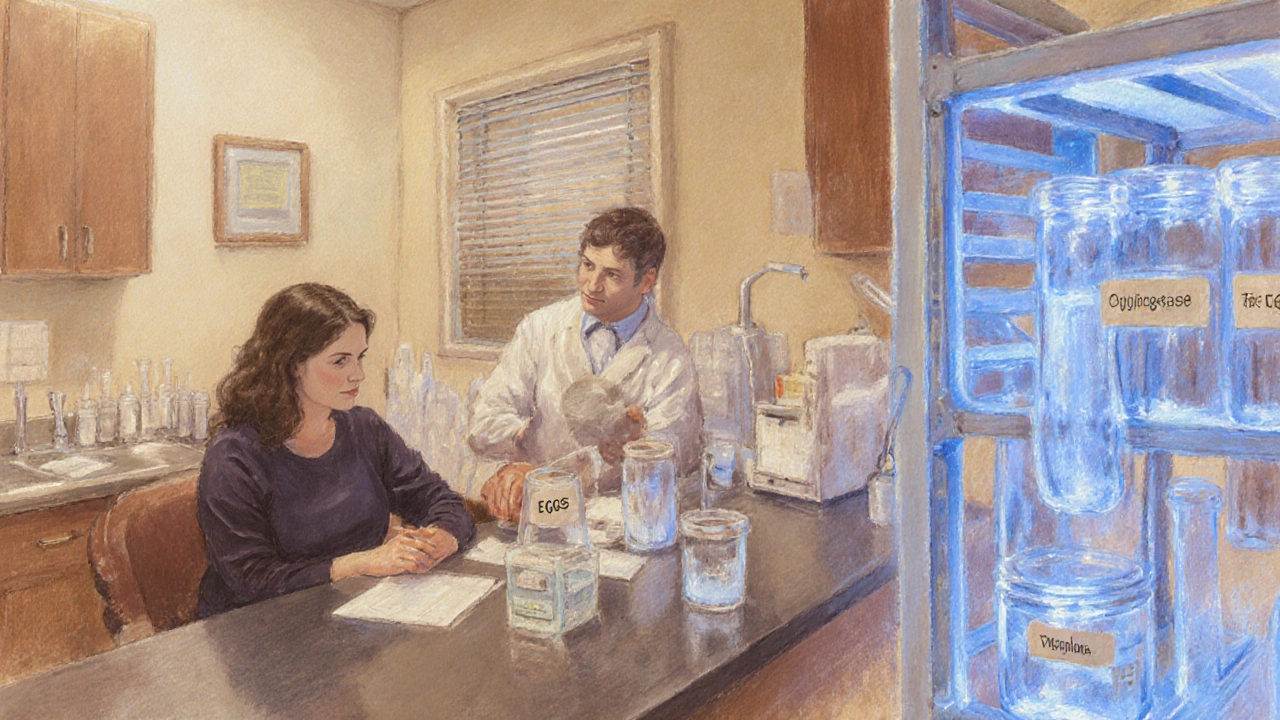Ovarian Cancer Survival and Treatment Calculator
Enter Patient Information
Estimated Prognosis and Recommendations
When Ovarian Cancer is diagnosed in a woman under 40, the news feels like a double punch: a life‑threatening disease and a sudden shift in future plans. While ovarian cancer overall accounts for about 2.5% of all cancers in women, only 10‑15% of those cases occur in women younger than 45. This age group faces unique hurdles - from fertility worries to navigating work and relationships - that aren’t always front‑and‑center in standard treatment guides.
Why Young Women Experience Different Challenges
First, the disease often masks itself. Ovarian Cancer in younger patients tends to present with vague abdominal discomfort, bloating, or irregular periods, leading to an average diagnostic delay of 3‑6 months, compared with 1‑2 months in older cohorts. Missed opportunities for early detection mean the cancer is frequently staged III or IV at diagnosis, demanding more aggressive therapy.
Second, treatment side effects hit personal milestones harder. Chemotherapy regimens like carboplatin and paclitaxel can cause temporary infertility, hair loss, and neuropathy - all while many women are building careers, starting families, or caring for aging parents.
Third, the emotional fallout is amplified. Young adults are navigating identity formation, and a cancer diagnosis can trigger anxiety, depression, and a sense of isolation. Studies from the National Cancer Institute (2023) show that 56% of women under 40 with ovarian cancer report clinically significant distress, versus 34% of older patients.
Key Medical Considerations for Young Patients
Genetic Testing becomes a priority. Roughly 15‑20% of ovarian cancers are linked to hereditary mutations, most notably BRCA1/BRCA2. Identifying these mutations not only guides treatment (PARP inhibitors are especially effective) but also informs family‑wide risk management.
Choosing a specialist matters. A Gynecologic Oncologist with experience in fertility‑sparing approaches can tailor surgery to preserve reproductive organs when oncologically safe.
When chemotherapy is unavoidable, options like dose‑dense schedules or intraperitoneal delivery may improve survival but also increase short‑term toxicity. Discussing these trade‑offs early helps set realistic expectations.

Preserving Fertility: What Options Exist?
Fertility preservation is no longer an afterthought. The two most common methods are:
| Method | Procedure Timing | Success Rate (live birth) | Key Considerations |
|---|---|---|---|
| Egg Freezing (Vitrification) | After ovarian stimulation (10‑14 days) | 40‑55% (depending on age at freezing) | Requires hormone stimulation; may delay cancer treatment by 2‑3 weeks. |
| Ovarian Tissue Cryopreservation | During surgery or via laparoscopic biopsy | ~30% (still experimental) | Can be done immediately; viable for pre‑pubertal patients. |
| Embryo Freezing | Similar to egg freezing, but fertilized with partner/sperm donor | 45‑60% | Legal and ethical considerations; requires a partner or donor sperm. |
All three methods are offered at major cancer centers in Australia, the U.S., and Europe. Discussing costs (often covered partially by private health insurance or government programs) and timeline with your care team ensures you don’t miss the window before starting chemotherapy.
Psychosocial Support: Building an Emotional Safety Net
Beyond medical treatment, Psychosocial Support is a cornerstone of survivorship for young women. Here are the most effective avenues:
- Counselling - Licensed therapists familiar with oncology can teach coping skills, address body‑image concerns, and manage relationship stress.
- Support Groups - Both in‑person (e.g., Ovarian Cancer Australia’s Young Women’s Circle) and virtual communities provide peer validation. A 2022 survey found that participants in regular support groups reported a 25% improvement in quality‑of‑life scores.
- Mentorship Programs - Pairing newly diagnosed patients with long‑term survivors offers real‑world hope and practical advice.
- Mind‑Body Therapies - Yoga, meditation, and acupuncture have been shown to reduce chemotherapy‑related fatigue by up to 30%.
Many hospitals now embed a Social Worker into the oncology team, ensuring you get referrals early rather than scrambling later.
Financial and Practical Help
Facing a serious illness in your 20s or 30s often collides with financial milestones - mortgages, student loans, and career advancement. Here’s a quick checklist of resources:
- Government Subsidies: In Australia, the National Disability Insurance Scheme (NDIS) can fund home‑care aides and transport. In the U.S., the Social Security Disability Insurance (SSDI) provides income after a 5‑month waiting period.
- Charitable Grants: Organizations like the Ovarian Cancer Research Fund (OCRF) and Hope for Ovarian Cancer offer one‑time grants for medical bills, fertility procedures, and childcare.
- Employer Assistance: Many large employers have “cancer caregiver” policies that allow flexible work hours, remote work, or paid leave.
- Legal Advice: If you’re concerned about employment rights or insurance discrimination, a certified Legal Counsel specializing in health law can be invaluable.
Documenting all expenses from day one helps you later when applying for reimbursements or tax deductions.

Living Beyond Diagnosis: Long‑Term Follow‑Up
Survivorship doesn’t stop after remission. Recommended follow‑up for young women includes:
- Every 3‑4 months imaging (CT or MRI) for the first 2 years.
- CA‑125 blood tests monitored alongside imaging; rising levels may signal recurrence.
- Annual genetic counselling if a hereditary mutation was found.
- Continued mental‑health check‑ins - depression rates remain elevated up to 5 years post‑treatment.
Adhering to this schedule improves early detection of recurrence, which is crucial because secondary surgeries have a higher chance of achieving disease‑free status when caught early.
Quick Checklist for Young Women Facing Ovarian Cancer
- Ask for a referral to a Gynecologic Oncologist with fertility‑preservation experience.
- Request genetic testing for BRCA and other hereditary markers.
- Discuss all fertility‑preservation options before starting chemo.
- Enroll in a psychosocial support program within the first month of diagnosis.
- Map out financial assistance - government, charitable, employer, and legal resources.
- Set up a survivorship care plan that includes imaging, labs, and mental‑health follow‑up.
Remember, you’re not tackling this alone. Each step on this list connects you to a network of professionals, peers, and resources designed to keep you healthy, hopeful, and empowered.
Frequently Asked Questions
Can ovarian cancer be cured in women under 40?
Cure rates depend on stage at diagnosis. For stage I disease, five‑year survival exceeds 90%. Advanced stages drop to 30‑45% even with aggressive therapy, but newer targeted drugs (PARP inhibitors) are improving outcomes, especially for BRCA‑mutated tumors.
How long does it take to freeze eggs, and will it delay cancer treatment?
Egg freezing requires ovarian stimulation for 10‑14 days, followed by a retrieval procedure. In most cases, treatment can start within 2‑3 weeks after retrieval. Some centers offer “random‑start” protocols that begin stimulation at any point in your menstrual cycle, minimizing delay.
What mental‑health services are specifically for young adult cancer patients?
Many hospitals have dedicated Young Adult Oncology Psychosocial Programs. These include individual therapy, group counseling, and art or music therapy tailored to the 18‑39 age group. Online platforms like CancerCare and Teen Cancer America also offer peer‑matched counseling.
Is it safe to become pregnant after ovarian cancer treatment?
Pregnancy is generally safe after a disease‑free interval of at least 12‑18 months, assuming the uterus and remaining ovary (if any) are intact. Your oncologist will review your specific regimen; some chemotherapy agents are contraindicated close to conception.
Where can I find financial assistance for fertility preservation?
In Australia, the Health Insurance Compensation Fund may cover a portion of the cost. In the U.S., the Preserve Hope Foundation provides grants up to $10,000. Check with your hospital’s social work department for local charities and government subsidies.



What a thorough guide, bravo! The emphasis on genetic testing, fertility preservation, and psychosocial support really hits the mark, especially for young women trying to balance dreams and treatment. Early detection is vital, yet the subtle symptoms often masquerade as everyday issues, so raising awareness is crucial. I love how the article blends medical facts with practical resources, making it both informative and actionable. Keep up the great work, and thank you for shedding light on this often‑overlooked population.
Esteemed readers, the content herein provides a comprehensive overview of the challenges faced by women under forty confronting ovarian carcinoma. It is, however, prudent to note that certain statistical references could benefit from further clarification; for instance, the figure of "56%" pertaining to distress levels warrants citation of the original study, lest misinterpretation ensue. Additionally, while the fertility preservation table is invaluable, a brief discussion on the ethical considerations surrounding embryo freezing would enhance its depth. Nonetheless, the article is commendable in its scope and execution; a well‑crafted piece indeed, albeit with minor room for refinement.
Hey there, I just wanted to say that reading this article felt like a warm hug on a rough day. The way it talks about the fear of losing fertility really hits home for many of us who are still dreaming about having kids someday.
It’s good to know there are options like egg freezing, even if it means a short delay before chemo.
The explanation about "random‑start" protocols makes the process sound less scary, and I think that’s important for anyone hesitating to start treatment because they worry about timing.
What really stood out to me was the emphasis on mental health support – the list of counseling, support groups, and mind‑body therapies is thorough and practical.
In my experience, having a therapist who understands cancer can make a huge difference in coping with the emotional roller‑coaster.
The article also mentions mentorship programs, which I think are priceless; hearing a survivor’s story can restore hope and give concrete advice on handling day‑to‑day challenges.
I appreciate the clear financial checklist; keeping track of expenses early can prevent a lot of stress later on.
It’s also helpful that the piece highlights government subsidies like NDIS and SSDI, which many patients might overlook while focusing on medical treatment.
The follow‑up schedule is detailed, reminding us that survivorship care doesn’t end after remission – a point that is often missed in other resources.
Overall, the article feels like a roadmap that guides you step by step, from diagnosis through treatment, fertility decisions, emotional support, and long‑term care.
It’s reassuring to see that each stage is addressed with empathy and practical advice.
Thank you for putting together such a comprehensive, user‑friendly guide; it makes a tough journey feel a bit more manageable.
The article is commendably exhaustive; however, a few grammatical oversights merit attention. In the sentence "Pregnancy is generally safe after a disease‑free interval of at least 12‑18 months," the word "generally" should be set off by commas for clarity: "Pregnancy, generally, is safe after a disease‑free interval…" Additionally, the phrase "the two most common methods are" would be more precise as "the two most common methods are as follows." Such refinements would enhance the already high standard of the piece.
I must say, this guide struck a chord deep within me; the combination of factual precision and heartfelt concern is truly admirable. While the medical details are spot‑on, the emotional resonance of acknowledging a young woman’s fear about fertility is especially moving. It is refreshing to see an article that does not shy away from the raw feelings involved, yet still maintains impeccable grammar. Thank you for delivering information with both clarity and compassion.
This article is useful :)
While the piece offers a plethora of data, one cannot ignore the underlying moral implications of presenting fertility preservation as merely a "option" without addressing the profound ethical dilemmas it imposes on women whose values may conflict with such interventions. It is, in essence, a drama of choice versus necessity, and the article should not gloss over the societal pressures that compel young women to prioritize motherhood even amidst life‑threatening illness.
Honestly, if you’re still reading this after the first paragraph, you’ve missed the point-most of this is just rehashing what every oncologist already tells you. Sure, the table is “helpful,” but anyone with a Google search knows the basics of egg freezing. Also, the phrase "young women" is overused; maybe specify age brackets? Anyway, good luck navigating the jargon, but the real insight is missing.
From a cultural perspective, it’s striking how universally these concerns echo across continents-whether in the U.S., India, or Europe, the blend of medical urgency and personal aspiration remains consistent. The article does well to bridge that gap, offering resources that feel applicable regardless of local health systems. It reminds us that, despite differing healthcare infrastructures, the core human experience of confronting illness and preserving hope is shared worldwide.
It is imperative that we uphold the dignity of our nation’s youth by ensuring they receive the best possible care, supported by robust governmental aid and ethical medical practices. The thoroughness of this guide reflects a commitment to excellence that aligns with our country’s values of perseverance and responsibility.